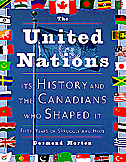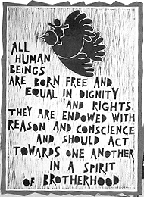


|
The United Nations: Its History and the Canadians Who Shaped It.
Desmond Morton. Subject Headings:
Grades 5 - 9 / Ages 10 - 14.
|
excerpt:
If you and other people in your neighbourhood wanted to get something done, you begin by getting organized. Why not start a neighbourhood association? You would need to hold a meeting, or assembly, where each family would have one vote. If fighting is a problem in your area, you might choose a special peace committee. It would be smart to include the richest and most important families on the committee, because if they don't keep the peace, no one will. You could also form a committee to improve living conditions. And since there'll probably be arguments in your neighbourhood, how about a "court" to find a fair agreement.
The UN has all of these organizations and many more.
On October 24, 1945, a group of thirty-one countries formally joined together to become the United Nations. Their purpose was to "save succeeding generations from the scourge of war." This year marks the fiftieth anniversary of the founding of the UN, and in honour of that, many books on the institution are being published. Distinguished Canadian historian Desmond Morton has written The United Nations: Its History and the Canadians Who Shaped It, a book directed at Canadian youth.


Recommended.
Caroline Thomson is a librarian in North York, Ontario. She holds an M.A. in history.
For ordering information contact Kids Can Press at 1-800-565-9523
![]()
Copyright © 1995 the Manitoba Library Association.
Reproduction for personal use is permitted only if this copyright notice
is
maintained. Any other reproduction is prohibited without permission.
Published by
The Manitoba Library Association
ISSN 1201-9364
 Go back to CM Welcome page
Go back to CM Welcome page
 Go back to Table of
Contents for this Issue
Go back to Table of
Contents for this Issue